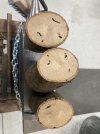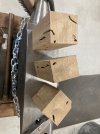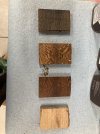And since it is on topic I am also posting the olive root burl I split two years ago. I have two nice blocks that are dry now and I will cut the blocks from rest soon.
The story that goes with it is even better. My future wife is Sicilian and I was changing jobs, so we went on a trip around Italy. My mission was to find olive wood, so from north till south every place we passed, I was asking around for olive wood. My future wife was already desperate about it.
After reaching Sicily and her family after two weeks, I was almost ready to give up. We were calling around all the timber and wood shop places that we could find on the way and still had no luck.
But as it goes, once I relaxed and stopped hoping, in Argento on the way to beach, hottest week in European history (40-50°C), and on the very day of the national holiday (Ferraggosto), we noticed a sign saying “seggeria" on the local country road. I followed the sign and we reached the seggheria around noon.
Once I saw a heap of wood and a large bandsaw my hopes got up. After noone was responding the bell, I only had to muster the courage to enter the closed gateway and a pitbull governing the entrance. I rang the bell and a small, bulky and sun stricken man came to great me. I didn't understand his dialect and he didn't understand my Italian, but I somehow managed to explain that I am looking for olive wood. He was about to give me some straight grained wood, when I noticed the root burl on the heap of wood behind the house.
He was trying to explain me that this wood is no good, but he still cut it up in smaller pieces and didn't want to take neither money nor the beer I had in the car. I love the story and love that burl, first piece is going on a knife for myself.
Sorry for the ramble...


















